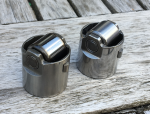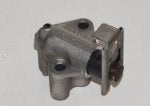Just joining this now - thanks
TT'sRevenge for your advice on PCV and chain tensioner.
My TT is a 2011 CESA 130k miles on the clock (and I want to keep long term) - and perhaps worth saying that there seems to be very little out there - especially on Youtube - that represents this engine. I'd like to think that because its a Gen 2 it suffers from fewer issues than some of the other/previous variants of the TT engine?
It's unique in that the CESA is the only transverse implementation of the Gen 2 engine. The B8 A4/A5/Q5 all used this engine, and since they debuted, but in the longitudinal variants (common codes like CDNC, CAEA, etc). So the Mk2 TT is the only transverse car* that got this engine. That's why you don't see much on YT. It's better (for ppl with this engine) to watch vids on A4/A5/Q5s, since it's the same thing only mounted the other way. But really the main difference to the Gen 1 is simply the valve-lift system. The rest is pretty much the same physically, from the outside.
*Note when I say "only transverse car" it's possible some Seat or other car make we don't get over here also got it and I'm just not aware.
I've talked to the chap who looks after my TT about timing belts and chains as well as PCV and he seems to take a more relaxed view as he regularly checks my car and would know if anything was due to 'go'. I'm pretty sure he once said to me that the timing chain had an auto tensioner which reduces the need to change it, but I could be wrong??
I'm guessing that you speak from bitter experience
TT'sRevenge and what you say has only strengthened my resolve in having these two areas looked at.
Haha thankfully I'm
not--I never had this fail but seen many horror stories. I had an MY08 A3 with a CCTA engine which
would have had that old tensioner but that car was written off in an accident before the problem was even well-known. The MY13 A3 I still have, also has a CCTA engine but it was built with the updated tensioner...thankfully. However it still has the old chain, and it's getting up there in miles so I'm probably going to do the full timing job next year. Last time I checked the timing value it wasn't too far away from the "time for a timing job" value, so it's pretty much that time now. Sucks because it's nowhere near the 175k kms one could get out of the belt on the EA113s, but them's the breaks. At least putting the K04 on (which I did like 5-6 years ago) was easier and cheaper since I didn't have to upgrade the HPFP or injectors

Again though if you have the old tensioner,
get it out. This is the one piece of advice that should be taken on any EA888 Gen 1 or 2 owner. Note that I never understood why they called the Gen 2, "Gen 2". It's not really anything newer in design, it's just the same engine designed at virtually the same time, with the VL system on it. So the tensioners are the same and were not revised (either engine because it's the same part) until some time in 2012. Cars manufactured prior to mid-2012 or so, would definitely have the old tensioner unless it has been changed after the car was bought. Even cars built
in 2012, it should definitely be
checked as it was a running change and who knows when they ran out of original tensioners. If you have an MY14 or later it's pretty certain you have the new one I would say. (The chain I don't think was updated until CY14 or possibly 15, meaning the majority of these engines do have the old chain.) Chain wear is more something that can be detected though, and replaced before anything bad happens. The tensioner is a different story--when that spring clip goes AWOL it's a sudden game over, just like that. No warnings, just one day your engine is done for. A lot of people have had this happen from a cold start, just like that. The earlier failures were luckily covered by warranty--I recall some people had entire engines replaced. However if you somehow still have this tensioner in a car today you're almost certainly out of warranty and the time to get it out of there is NOW!
On the roller tappet follower, and actually because I believed (Youtube) that my car had the earlier follower that is prone to wear and should be changed if this is the case, I replaced my roller type with a new one. Pics below. Probably didn't need changing in retrospect, but it has a new one now and new seal too, so peace of mind/belt & braces etc!
Pics - old follower on left - new one on the right side.
Great to see the CESA engine discussed here though - always interested in anything that will extend the life of my TT or help me future-proof it.
While the follower would wear I guess, I've never heard of it being that much of a problem. I did have the HPFP fail on my 08 car probably after like a year or two. It was replaced under warranty but I never dug any deeper as to
what exactly failed or how it failed. I also heard about other HPFP failures around that time but never anything more than the same--ppl had theirs fail and replaced under warranty. I think that was revised early on, like 2010 or so, so I don't think it was ever a lasting problem or concern. If you've replaced it, sounds good but I'm not sure it's all that necessary. Never really heard of people taking this out and checking it periodically. I'm sure it can fail (any part can) but never seemed much of a concern.









